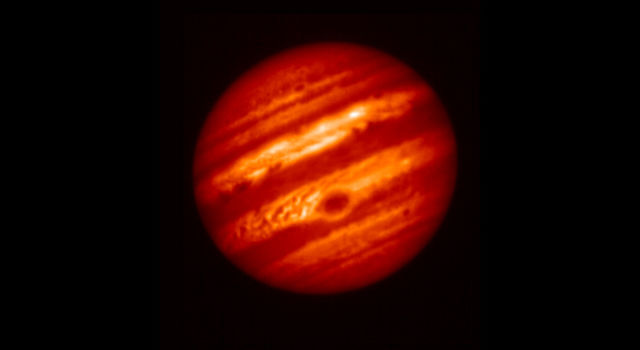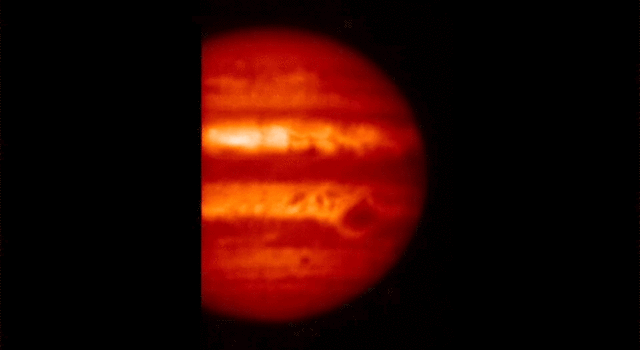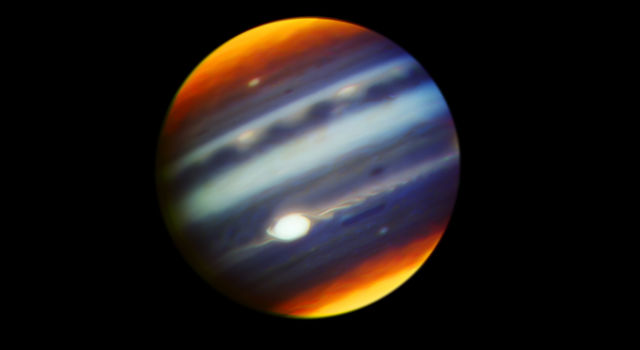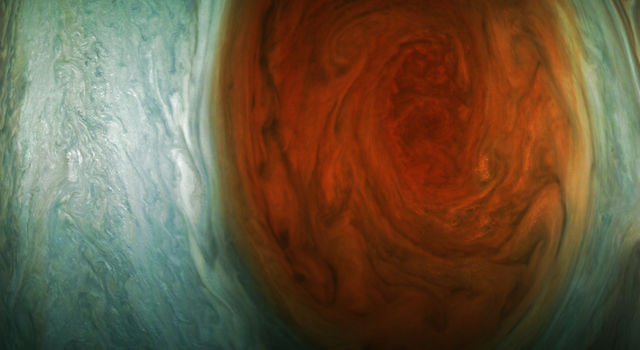2.07.2017
NASA's Juno Spacecraft to Fly Over Jupiter's Great Red Spot July 10
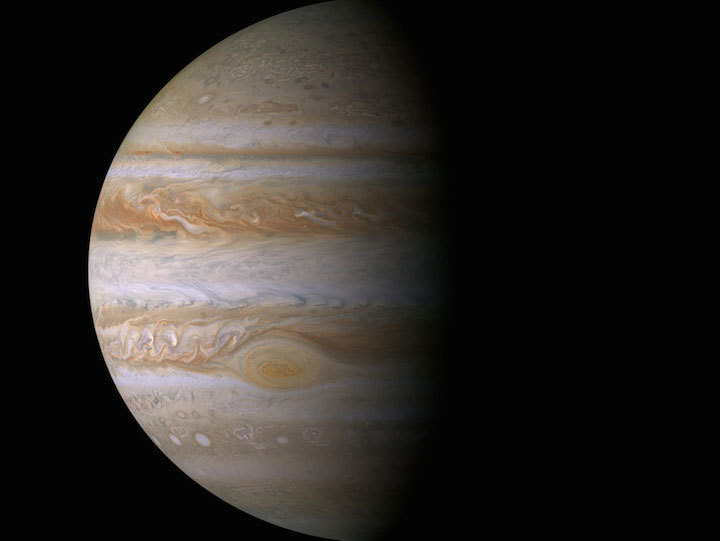
Just days after celebrating its first anniversary in Jupiter orbit, NASA's Juno spacecraft will fly directly over Jupiter's Great Red Spot, the gas giant's iconic, 10,000-mile-wide (16,000-kilometer-wide) storm. This will be humanity's first up-close and personal view of the gigantic feature -- a storm monitored since 1830 and possibly existing for more than 350 years.
"Jupiter's mysterious Great Red Spot is probably the best-known feature of Jupiter," said Scott Bolton, principal investigator of Juno from the Southwest Research Institute in San Antonio. "This monumental storm has raged on the solar system's biggest planet for centuries. Now, Juno and her cloud-penetrating science instruments will dive in to see how deep the roots of this storm go, and help us understand how this giant storm works and what makes it so special."
The data collection of the Great Red Spot is part of Juno's sixth science flyby over Jupiter's mysterious cloud tops. Perijove (the point at which an orbit comes closest to Jupiter's center) will be on Monday, July 10, at 6:55 p.m. PDT (9:55 p.m. EDT). At the time of perijove, Juno will be about 2,200 miles (3,500 kilometers) above the planet's cloud tops. Eleven minutes and 33 seconds later, Juno will have covered another 24,713 miles (39,771 kilometers) and will be directly above the coiling crimson cloud tops of Jupiter's Great Red Spot. The spacecraft will pass about 5,600 miles (9,000 kilometers) above the Giant Red Spot clouds. All eight of the spacecraft's instruments as well as its imager, JunoCam, will be on during the flyby.
On July 4 at 7:30 p.m. PDT (10:30 p.m. EDT), Juno will have logged exactly one year in Jupiter orbit. At the time, the spacecraft will have chalked up about 71 million miles (114.5 million kilometers) in orbit around the giant planet.
"The success of science collection at Jupiter is a testament to the dedication, creativity and technical abilities of the NASA-Juno team," said Rick Nybakken, project manager for Juno from NASA's Jet Propulsion Laboratory in Pasadena, California. "Each new orbit brings us closer to the heart of Jupiter's radiation belt, but so far the spacecraft has weathered the storm of electrons surrounding Jupiter better than we could have ever imagined."
Juno launched on Aug. 5, 2011, from Cape Canaveral, Florida. During its mission of exploration, Juno soars low over the planet's cloud tops -- as close as about 2,100 miles (3,400 kilometers). During these flybys, Juno is probing beneath the obscuring cloud cover of Jupiter and studying its auroras to learn more about the planet's origins, structure, atmosphere and magnetosphere.
Early science results from NASA's Juno mission portray the largest planet in our solar system as a turbulent world, with an intriguingly complex interior structure, energetic polar aurora, and huge polar cyclones.
JPL manages the Juno mission for the principal investigator, Scott Bolton, of Southwest Research Institute. The Juno mission is part of the New Frontiers Program managed by NASA's Marshall Space Flight Center in Huntsville, Alabama, for the Science Mission Directorate. Lockheed Martin Space Systems, Denver, built the spacecraft. JPL is a division of Caltech in Pasadena.
Quelle: NASA
+++
Earth-based Views of Jupiter to Enhance Juno Flyby
› Full image and caption
Telescopes in Hawaii have obtained new images of Jupiter and its Great Red Spot, which will assist the first-ever close-up study of the Great Red Spot, planned for July 10. On that date, NASA's Juno spacecraft will fly directly over the giant planet's most famous feature at an altitude of only about 5,600 miles (9,000 kilometers).
Throughout the Juno mission, numerous observations of Jupiter by Earth-based telescopes have been acquired in coordination with the mission, to help Juno investigate the giant planet's atmosphere. On May 18, 2017, the Gemini North telescope and the Subaru Telescope, both on Hawaii's Mauna Kea peak, simultaneously examined Jupiter in very high resolution at different wavelengths. These latest observations supplement others earlier this year in providing information about atmospheric dynamics at different depths at the Great Red Spot and other regions of Jupiter.
The Great Red Spot is a swirling storm, centuries old and wider than the diameter of Earth. Juno will use multiple instruments to study this feature when it flies over it about 12 minutes after the spacecraft makes the closest approach to Jupiter of its current orbit at 6:55 p.m. on July 10, PDT (9:55 p.m. on July 10, EDT; 1:55 a.m. on July 11, Universal Time). Juno entered orbit around Jupiter on July 4, 2016.
"Observations with Earth's most powerful telescopes enhance the spacecraft's planned observations by providing three types of additional context," said Juno science team member Glenn Orton of NASA's Jet Propulsion Laboratory, Pasadena, California. "We get spatial context from seeing the whole planet. We extend and fill in our temporal context from seeing features over a span of time. And we supplement with wavelengths not available from Juno. The combination of Earth-based and spacecraft observations is a powerful one-two punch in exploring Jupiter."
Orton collaborated with researchers at Gemini; Subaru; the University of California, Berkeley; Tohoku University, Japan; and elsewhere in planning the recent observations.
The observers used Gemini North on May 18 to examine Jupiter through special near-infrared filters. The filters exploit specific colors of light that can penetrate the upper atmosphere and clouds of Jupiter, revealing mixtures of methane and hydrogen in the planet's atmosphere. These observations showed a long, fine-structured wave extending off the eastern side of the Great Red Spot.
On the same night, researchers used Subaru's Cooled Mid-Infrared Camera and Spectrometer (COMICS), with filters sensitive to temperatures at different layers of Jupiter's atmosphere. These mid-infrared observations showed the Great Red Spot "had a cold and cloudy interior increasing toward its center, with a periphery that was warmer and clearer," Orton said. "A region to its northwest was unusually turbulent and chaotic, with bands that were cold and cloudy, alternating with bands that were warm and clear."
Quelle: NASA
---
8.07.2017
.
Just days after celebrating its first anniversary in Jupiter orbit, NASA's Juno spacecraft will fly directly over Jupiter's Great Red Spot, the gas giant's iconic, 10,000-mile-wide (16,000-kilometer-wide) storm. This will be humanity's first up-close and personal view of the gigantic feature -- a storm monitored since 1830 and possibly existing for more than 350 years.
"Jupiter's mysterious Great Red Spot is probably the best-known feature of Jupiter," said Scott Bolton, principal investigator of Juno from the Southwest Research Institute in San Antonio. "This monumental storm has raged on the solar system's biggest planet for centuries. Now, Juno and her cloud-penetrating science instruments will dive in to see how deep the roots of this storm go, and help us understand how this giant storm works and what makes it so special."
The data collection of the Great Red Spot is part of Juno's sixth science flyby over Jupiter's mysterious cloud tops. Perijove (the point at which an orbit comes closest to Jupiter's center) will be on Monday, July 10, at 6:55 p.m. PDT (9:55 p.m. EDT). At the time of perijove, Juno will be about 2,200 miles (3,500 kilometers) above the planet's cloud tops. Eleven minutes and 33 seconds later, Juno will have covered another 24,713 miles (39,771 kilometers) and will be directly above the coiling crimson cloud tops of Jupiter's Great Red Spot. The spacecraft will pass about 5,600 miles (9,000 kilometers) above the Giant Red Spot clouds. All eight of the spacecraft's instruments as well as its imager, JunoCam, will be on during the flyby.
On July 4 at 7:30 p.m. PDT (10:30 p.m. EDT), Juno will have logged exactly one year in Jupiter orbit. At the time, the spacecraft will have chalked up about 71 million miles (114.5 million kilometers) in orbit around the giant planet.
"The success of science collection at Jupiter is a testament to the dedication, creativity and technical abilities of the NASA-Juno team," said Rick Nybakken, project manager for Juno from NASA's Jet Propulsion Laboratory in Pasadena, California. "Each new orbit brings us closer to the heart of Jupiter's radiation belt, but so far the spacecraft has weathered the storm of electrons surrounding Jupiter better than we could have ever imagined."
Juno launched on Aug. 5, 2011, from Cape Canaveral, Florida. During its mission of exploration, Juno soars low over the planet's cloud tops -- as close as about 2,100 miles (3,400 kilometers). During these flybys, Juno is probing beneath the obscuring cloud cover of Jupiter and studying its auroras to learn more about the planet's origins, structure, atmosphere and magnetosphere.
Early science results from NASA's Juno mission portray the largest planet in our solar system as a turbulent world, with an intriguingly complex interior structure, energetic polar aurora, and huge polar cyclones.
Quelle: NASA
---
Update: 10.07.2017
.
NASA Spacecraft Gets Up Close With Jupiter's Great Red Spot
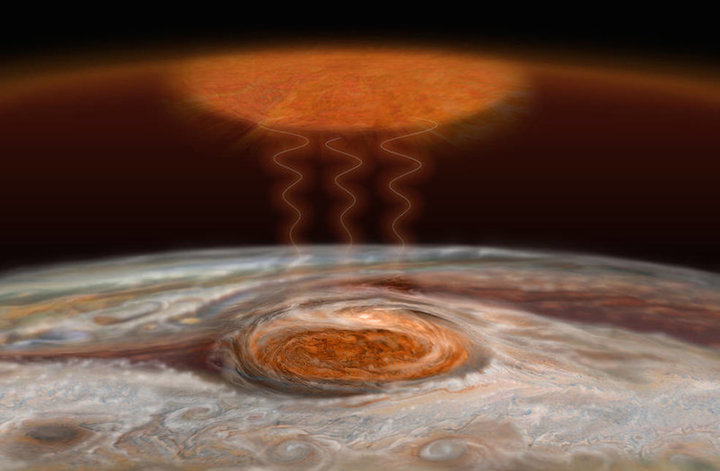
Artist's impression of Jupiter's Great Red Spot heating the upper atmosphere.
Scientists are about to get an up-close and personal look at the planet Jupiter's most famous landmark, the Great Red Spot.
NASA's Juno spacecraft will be directly over the spot shortly after 10 p.m. ET Monday,July 10, about 5,600 miles above the gas giant's cloud tops. That's closer than any spacecraft has been before.
The spot is actually a giant storm that has been blowing on Jupiter for centuries. It's huge, larger than Earth in diameter.
"It's lasted a really long time," says Scott Bolton of the Southwest Research Institute in San Antonio and principal scientist for NASA's Juno mission to Jupiter. "No scientists really understand exactly how that storm is created or why it could last so long."
Not only will Juno's camera be able to capture detailed images of the spot, but the probe also carries scientific instruments that can provide additional details about the storm. For example, the microwave radiometer can peer through the clouds and see what kinds of atmospheric structures underpin the spot.
"It's possible that the roots are quite deep," says Bolton. "So we'll be able to take a look at that and see what's underneath the cloud tops."
Bolton and his colleagues are planning to bring a lot of astronomical resources to bear during this flyby. Ground-based telescopes, Earth-orbiting telescopes, even amateur astronomers will be taking measurements of the planet around the time Juno gets there to provide as complete a picture of the storm as possible.
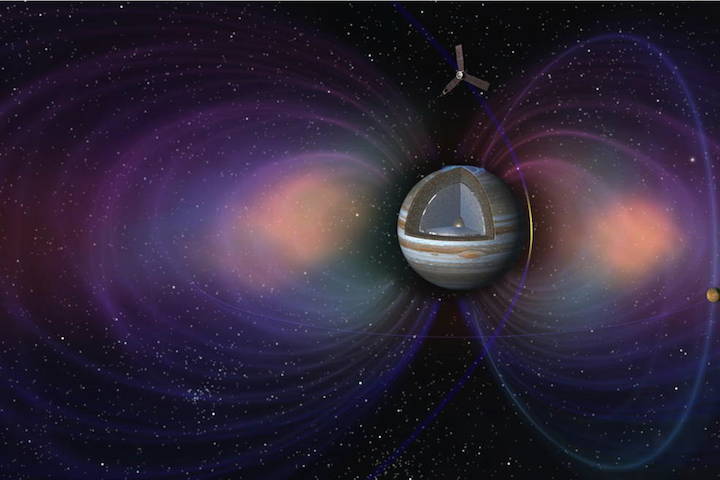
This artist's concept shows the pole-to-pole orbits of NASA's Juno spacecraft at Jupiter.
This isn't the last time Juno will pass over the spot. Once every 53 days the spacecraft's orbit takes it close to the planet. Each future flyby of the Red Spot will focus on a different kind of science.
Another Juno instrument can measure the gravity field around the spot. Bolton says there may be something massive below the spot that's contributing to its existence.
"Maybe there's a blob going around Jupiter that's underneath the Red Spot, and we may be able to see that," he says.
Imagine that. The Great Red Spot may have a Great Big Blob associated with it.
Juno's main antenna will be pointed away from Earth during the closest approach, so it will be a few days before the data and pictures stored on board can be downlinked to Earth.
Bolton is confident the images will be eye-popping when they arrive.
"Jupiter is stunning when you get near it," he says.
Quelle: npr
---
Update: 13.07.2017
.
NASA's Juno Spacecraft Spots Jupiter's Great Red Spot
› Full image and caption
Images of Jupiter's Great Red Spot reveal a tangle of dark, veinous clouds weaving their way through a massive crimson oval. The JunoCam imager aboard NASA's Juno mission snapped pics of the most iconic feature of the solar system's largest planetary inhabitant during its Monday (July 10) flyby. The images of the Great Red Spot were downlinked from the spacecraft's memory on Tuesday and placed on the mission's JunoCam website Wednesday morning.
"For hundreds of years scientists have been observing, wondering and theorizing about Jupiter's Great Red Spot," said Scott Bolton, Juno principal investigator from the Southwest Research Institute in San Antonio. "Now we have the best pictures ever of this iconic storm. It will take us some time to analyze all the data from not only JunoCam, but Juno's eight science instruments, to shed some new light on the past, present and future of the Great Red Spot."
As planned by the Juno team, citizen scientists took the raw images of the flyby from the JunoCam site and processed them, providing a higher level of detail than available in their raw form. The citizen-scientist images, as well as the raw images they used for image processing, can be found at:
https://www.missionjuno.swri.edu/junocam/processing
"I have been following the Juno mission since it launched," said Jason Major, a JunoCam citizen scientist and a graphic designer from Warwick, Rhode Island. "It is always exciting to see these new raw images of Jupiter as they arrive. But it is even more thrilling to take the raw images and turn them into something that people can appreciate. That is what I live for."
Measuring in at 10,159 miles (16,350 kilometers) in width (as of April 3, 2017) Jupiter's Great Red Spot is 1.3 times as wide as Earth. The storm has been monitored since 1830 and has possibly existed for more than 350 years. In modern times, the Great Red Spot has appeared to be shrinking.
All of Juno's science instruments and the spacecraft's JunoCam were operating during the flyby, collecting data that are now being returned to Earth. Juno's next close flyby of Jupiter will occur on Sept. 1.
Juno reached perijove (the point at which an orbit comes closest to Jupiter's center) on July 10 at 6:55 p.m. PDT (9:55 p.m. EDT). At the time of perijove, Juno was about 2,200 miles (3,500 kilometers) above the planet's cloud tops. Eleven minutes and 33 seconds later, Juno had covered another 24,713 miles (39,771 kilometers), and was passing directly above the coiling, crimson cloud tops of the Great Red Spot. The spacecraft passed about 5,600 miles (9,000 kilometers) above the clouds of this iconic feature.
Juno launched on Aug. 5, 2011, from Cape Canaveral, Florida. During its mission of exploration, Juno soars low over the planet's cloud tops -- as close as about 2,100 miles (3,400 kilometers). During these flybys, Juno is probing beneath the obscuring cloud cover of Jupiter and studying its auroras to learn more about the planet's origins, structure, atmosphere and magnetosphere.
Early science results from NASA's Juno mission portray the largest planet in our solar system as a turbulent world, with an intriguingly complex interior structure, energetic polar aurora, and huge polar cyclones.
"These highly-anticipated images of Jupiter's Great Red Spot are the 'perfect storm' of art and science. With data from Voyager, Galileo, New Horizons, Hubble and now Juno, we have a better understanding of the composition and evolution of this iconic feature," said Jim Green, NASA's director of planetary science. "We are pleased to share the beauty and excitement of space science with everyone."
JPL manages the Juno mission for the principal investigator, Scott Bolton, of Southwest Research Institute in San Antonio. The Juno mission is part of the New Frontiers Program managed by NASA's Marshall Space Flight Center in Huntsville, Alabama, for the Science Mission Directorate. Lockheed Martin Space Systems, Denver, built the spacecraft. JPL is a division of Caltech in Pasadena. More information on the Juno mission is available at:
The public can follow the mission on Facebook and Twitter at:
https://www.facebook.com/NASAJuno
https://www.twitter.com/NASAJuno
More information on the Great Red Spot can be found at:
https://www.nasa.gov/feature/goddard/jupiter-s-great-red-spot-a-swirling-mystery
https://www.nasa.gov/feature/jupiter-s-great-red-spot-likely-a-massive-heat-source
More information on Jupiter can be found at:
Quelle: NASA
---
Update: 14.07.2017
.
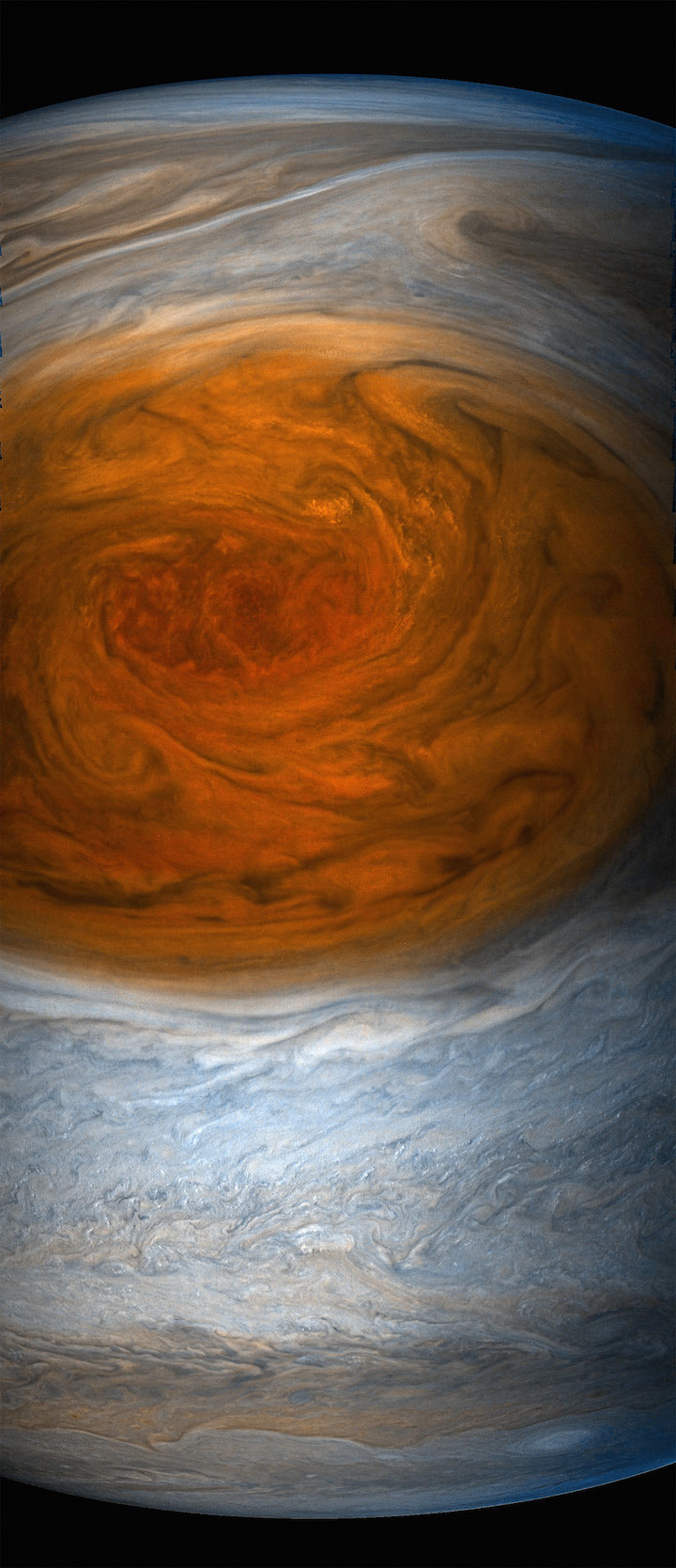
Images of Jupiter’s Great Red Spot reveal a tangle of dark, veinous clouds weaving their way through a massive crimson oval. The JunoCam imager aboard NASA's Juno mission snapped pics of the most iconic feature of the solar system’s largest planetary inhabitant during its Monday (July 10) flyby. The images of the Great Red Spot were downlinked from the spacecraft’s memory on Tuesday and placed on the mission’s JunoCam website Wednesday morning.
“For hundreds of years scientists have been observing, wondering and theorizing about Jupiter’s Great Red Spot,” said Scott Bolton, Juno principal investigator from the Southwest Research Institute in San Antonio. “Now we have the best pictures ever of this iconic storm. It will take us some time to analyze all the data from not only JunoCam, but Juno’s eight science instruments, to shed some new light on the past, present and future of the Great Red Spot.”
As planned by the Juno team, citizen scientists took the raw images of the flyby from the JunoCam site and processed them, providing a higher level of detail than available in their raw form. The citizen-scientist images, as well as the raw images they used for image processing, can be found at:
https://www.missionjuno.swri.edu/junocam/processing
“I have been following the Juno mission since it launched,” said Jason Major, a JunoCam citizen scientist and a graphic designer from Warwick, Rhode Island. “It is always exciting to see these new raw images of Jupiter as they arrive. But it is even more thrilling to take the raw images and turn them into something that people can appreciate. That is what I live for.”
Measuring in at 10,159 miles (16,350 kilometers) in width (as of April 3, 2017) Jupiter's Great Red Spot is 1.3 times as wide as Earth. The storm has been monitored since 1830 and has possibly existed for more than 350 years. In modern times, the Great Red Spot has appeared to be shrinking.
All of Juno's science instruments and the spacecraft's JunoCam were operating during the flyby, collecting data that are now being returned to Earth. Juno's next close flyby of Jupiter will occur on Sept. 1.
Juno reached perijove (the point at which an orbit comes closest to Jupiter's center) on July 10 at 6:55 p.m. PDT (9:55 p.m. EDT). At the time of perijove, Juno was about 2,200 miles (3,500 kilometers) above the planet's cloud tops. Eleven minutes and 33 seconds later, Juno had covered another 24,713 miles (39,771 kilometers), and was passing directly above the coiling, crimson cloud tops of the Great Red Spot. The spacecraft passed about 5,600 miles (9,000 kilometers) above the clouds of this iconic feature.
Juno launched on Aug. 5, 2011, from Cape Canaveral, Florida. During its mission of exploration, Juno soars low over the planet's cloud tops -- as close as about 2,100 miles (3,400 kilometers). During these flybys, Juno is probing beneath the obscuring cloud cover of Jupiter and studying its auroras to learn more about the planet's origins, structure, atmosphere and magnetosphere.
Early science results from NASA's Juno mission portray the largest planet in our solar system as a turbulent world, with an intriguingly complex interior structure, energetic polar aurora, and huge polar cyclones.
“These highly-anticipated images of Jupiter’s Great Red Spot are the ‘perfect storm’ of art and science. With data from Voyager, Galileo, New Horizons, Hubble and now Juno, we have a better understanding of the composition and evolution of this iconic feature,” said Jim Green, NASA’s director of planetary science. “We are pleased to share the beauty and excitement of space science with everyone.”
Quelle: NASA
---
Update: 28.07.2017
.
Jupiter’s Great Red Spot in True Color

This image of Jupiter’s iconic Great Red Spot was created by citizen scientist Björn Jónsson using data from the JunoCam imager on NASA’s Juno spacecraft.
This true-color image offers a natural color rendition of what the Great Red Spot and surrounding areas would look like to human eyes from Juno’s position. The tumultuous atmospheric zones in and around the Great Red Spot are clearly visible.
The image was taken on July 10, 2017 at 07:10 p.m. PDT (10:10 p.m. EDT), as the Juno spacecraft performed its seventh close flyby of Jupiter. At the time the image was taken, the spacecraft was about 8,648 miles (13,917 kilometers) from the tops of the clouds of the planet at a latitude of -32.6 degrees.
Quelle: NASA
---
Update: 5.08.2017
.
Jupiter Storm of the High North
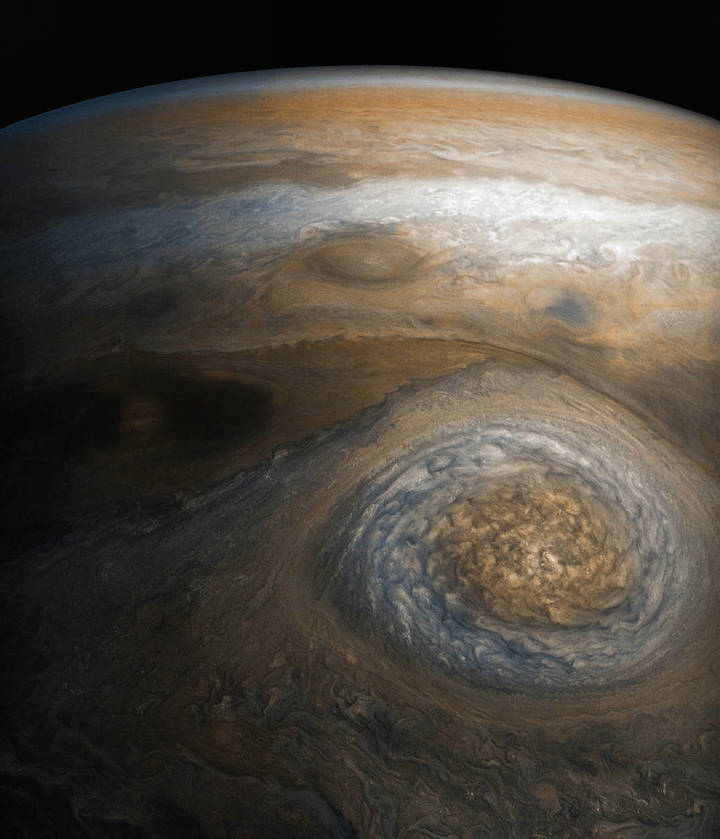
A dynamic storm at the southern edge of Jupiter’s northern polar region dominates this Jovian cloudscape, courtesy of NASA’s Juno spacecraft.
This storm is a long-lived anticyclonic oval named North North Temperate Little Red Spot 1 (NN-LRS-1); it has been tracked at least since 1993, and may be older still. An anticyclone is a weather phenomenon where winds around the storm flow in the direction opposite to that of the flow around a region of low pressure. It is the third largest anticyclonic oval on the planet, typically around 3,700 miles (6,000 kilometers) long. The color varies between red and off-white (as it is now), but this JunoCam image shows that it still has a pale reddish core within the radius of maximum wind speeds.
Citizen scientists Gerald Eichstädt and Seán Doran processed this image using data from the JunoCam imager. The image has been rotated so that the top of the image is actually the equatorial regions while the bottom of the image is of the northern polar regions of the planet.
The image was taken on July 10, 2017 at 6:42 p.m. PDT (9:42 p.m. EDT), as the Juno spacecraft performed its seventh close flyby of Jupiter. At the time the image was taken, the spacecraft was about 7,111 miles (11,444 kilometers) from the tops of the clouds of the planet at a latitude of 44.5 degrees.
Quelle: NASA
---
Update: 7.09.2017
.
What's Powering Auroras on Jupiter? NASA's Juno Probe Finds Puzzling Clues
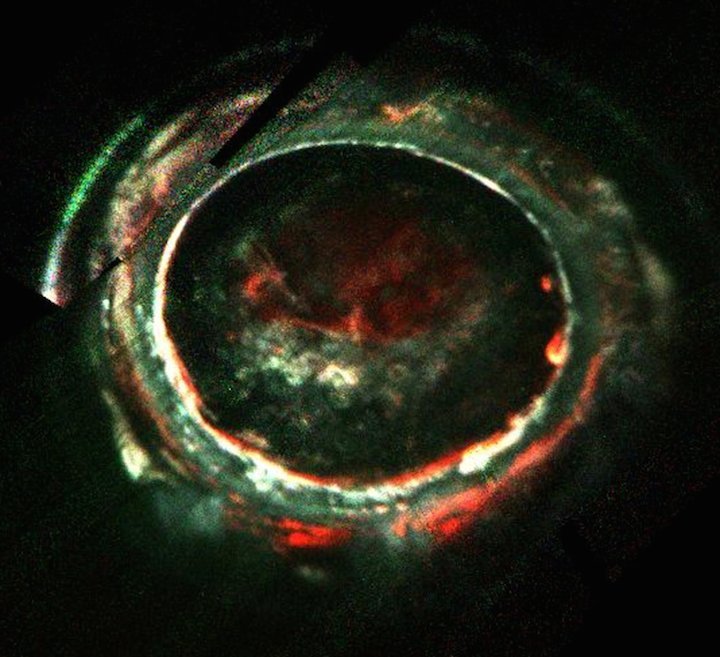
An image of Jupiter’s southern aurora, obtained by the Juno Ultraviolet Spectrograph (UVS) instrument on 2 February 2017. This image overlays three different UVS wavelength ranges and color codes them such that red, green, and blue indicate high, medium and low energy electrons impinging on the atmosphere, with color mixtures indicating a mixture of energies. The streak on the upper left is the auroral tail caused by Jupiter’s moon Io.
-
What's powering the powerful auroras at Jupiter's poles? New results suggest it's not the same mechanism powering the most energetic auroras on Earth, contrary to scientists' expectations.
Jupiter's aurorasare hundreds of times more energetic than those on Earth and don't radiate in wavelengthsthat are visible to the human eye. But both Jupiter's and Earth's light shows are manifestations of the same fundamental phenomenon: accelerated particles colliding with atoms in the atmosphere, releasing energy in the form of light.
Which is why researchers with NASA's Juno probe expected to find evidence that the charged particles that create Jupiter's auroras get their energy via the same mechanism that drives high-energy auroras on Earth, according to Barry Mauk, a scientist at the Johns Hopkins Applied Physics Laboratory and a member of the Juno collaboration.

The missing "V's"
In Earth's atmosphere, auroras are createdwhen the sun showers the planet with a stream of charged particles (known as the solar wind), which are pulled toward the poles by the magnetic field that wraps around the planet. The motion of charged particles along those magnetic field lines creates electric currents in the space above Earth’s atmosphere. This activity also creates electric potentials — think of them like power-up stations, where any charged particle that passes through gets an energy bump and is accelerated. If one of those accelerated particles comes down into the atmosphere and collides with an atom, the collision will cause enough energy to release visible light. This mechanism is responsible for the planet's most energetic auroras, which create those stunning light shows for viewers on the ground.
When a particle detector maps the particle energies around a powerful aurora, the researchers expect to see a peak where an electric potential is located. Mauk said they call those peaks "inverted V's," because that aptly describes the shape of the data line on the graph.
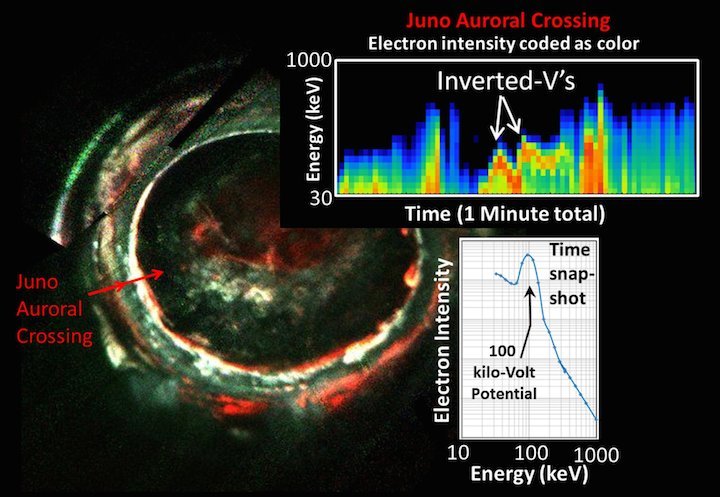
-
When the Juno probe began making close flybys of Jupiter, the spacecraft began collecting particle data with an instrument called the Jupiter Energetic-particle Detector Instrument (JEDI). (There is another particle instrument on Juno called Jovian Auroral Distributions Experiment, or JADE, that studies lower-energy particles involved in the aurora.) Mauk, who is principal investigator for the JEDI instrument, said researchers did see those inverted V's in their data, indicating these discrete electric potentials were accelerating particles above Jupiter's atmosphere.
"In one sense, this is a very simple result, because we observed huge electric potentials," Mauk said. "We've seen potentials of up to 400,000 volts, which is 10 to 30 times larger than what's been observed in Earth's aurora."
And yet, the results still puzzled Mauk and his colleagues, because the inverted V's appeared in only about 50 percent of Juno's flybys of Jupiter's most intense auroras. They simply couldn't be responsible for creating all of those intense auroras, even though this mechanism is responsible for creating Earth's most energetic auras. [AurorasOver Earth: Amazing Northern Lights Photos from Space]
Catching a wave
Juno's orbit around Jupiter brings it close to the giant planet every 53 days. During those close flybys, the probe can be traveling at top speeds of 55 kilometers per second, or more than 123,000 mph (198,000 km/h). As a result, the instruments may be able to collect data over the auroras for only about 2 seconds, Mauk said. The authors noticed the discrepancy between their expectations and what the data showed them, after the very first science flyby. In their new paper, they confirm those findings based on data from four science flybys.
Based on their measurements of particle energies around the auroras, the authors think it's likely that rather than getting boosted to a specific energy level, the particles are being gradually accelerated to a wider range of energies. The mechanism is what the authors call "stochastic acceleration" or "turbulent acceleration," and it is responsible for creating some of the weaker auroras in Earth's atmosphere. (Typically, these auroras are not visible to the human eye.)
In turbulent acceleration, the particles are essentially catching a ride on waves in the plasma that lies just above Jupiter's atmosphere, according to Mauk. (Plasma is a gas in which the electrons that typically orbit the nucleus of an atom have been freed, or ionized). Like surfers on the ocean, the particles are accelerated by the waves.
"The wave exchanges just a little bit of energy with the electron. And then [the electron] goes on to exchange energy with another wave. And slowly but surely the particle gains a huge amount of energy by interacting with thousands of different waves," Mauk said. "The result of that is a statistical distribution of energy. Some particles have intermediate energy, some have very high energy, so you get a broad distribution of energy. That's what we see in the energy fluxes."
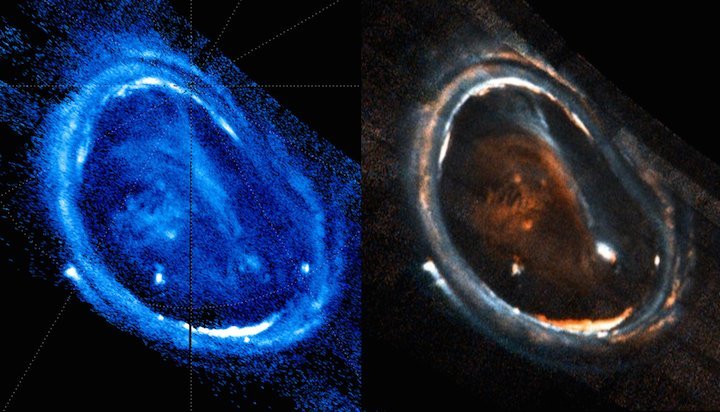
Jupiter’s northern aurora imaged by the Juno Ultraviolet Spectrograph (UVS) on Dec. 11 2016. The left panel false-colors the aurora based on overall intensity. The right panel overlays three different wavelength ranges and color codes them such that red, green, and blue indicate high, medium and low energy electrons, respectively, with color mixtures indicating a mixture of energies.
-
But this is still a hypothesis, Mauk said, and the researchers aren't sure yet how those waves are generated; if they emerge as a result of the energy potentials or from some other source.
Juno's orbit will take it on slightly shifted paths around Jupiter, meaning it will fly over different regions of the planet. The probe's orbit will also allow it to reach lower altitudes over the places where the charged particles are accelerated. (Lucky for the JEDI team, Jupiter's auroras are constant, because they are fed by the solar wind as well as a steady supply of charged particles from the moon Io.) Those low-altitude passes could "provide perspective that allows the differences between Earth and Jupiter auroras to be better understood," Mauk told Space.com.
The paper was published online today (Sept. 6 in the journal Nature.
Quelle: SC
---
Update: 20.09.2017
-
Jaw-Dropping Jupiter: Juno Probe Snaps Dramatic Up-Close Views of Planet
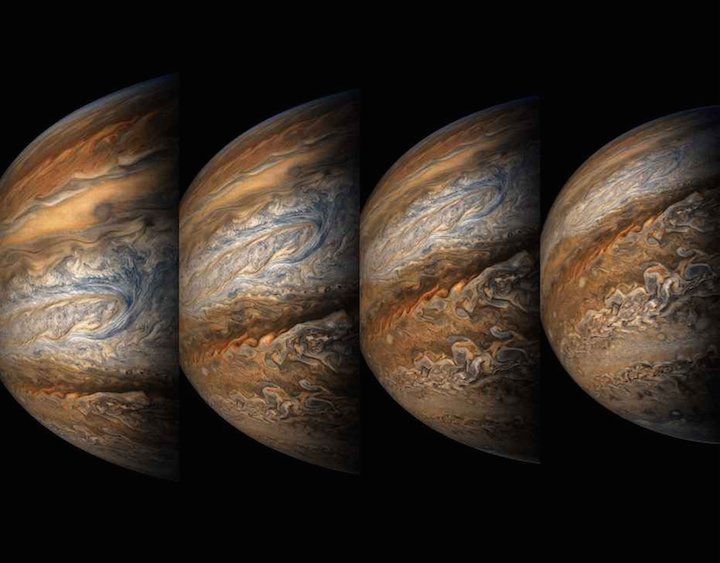
Citizen scientists Gerald Eichstätt and Sean Doran created this color-enhanced view of Jupiter using imagery captured by NASA's Juno spacecraft during its eighth close flyby of Jupiter, on Sept. 1, 2017.
-
New photos by NASA's Juno spacecraft capture the solar system's largest planet in all its complex glory.
The four photos — which Juno took over an 8-minute span on Sept. 1, during its most recent close flyby of Jupiter — show the gas giant's many cloud bands and countless swirling storms (but not the famous Great Red Spot).
"At the times the images were taken, the spacecraft ranged from 7,545 to 14,234 miles (12,143 to 22,908 kilometers) from the tops of the clouds of the planet at a latitude range of -28.5406 to -44.4912 degrees," NASA officials wrote in a description of the images.
The new photos actually represent a collaboration between Juno and citizen scientists Gerald Eichstädt Sean Doran, who processed raw imagery collected by the probe's JunoCam instrument into these dramatic, color-enhanced views.
NASA encourages anyone to process Juno pictures in this manner. If you're interested, go to the JunoCam page here: https://www.missionjuno.swri.edu/junocam.
The $1.1 billion Juno mission launched in August 2011 and arrived in orbit around Jupiter on July 4, 2016. Since then, the spacecraft has been studying the giant planet's structure, composition, and magnetic and gravitational fields, gathering data that mission scientists say should shed light on Jupiter's formation and evolution.
Juno is in a highly elliptical orbit that brings it close to the planet once every 53.5 Earth days. The spacecraft collects most of its data during these close passes; it has now completed eight of them.
Juno is scheduled to keep studying Jupiter through July 2018, though the probe won't necessarily cease operations then; NASA could end up granting an extending mission.
Quelle: SC
+++
MAP OF THE PJ7 CLOSEUP IMAGES
Gerald Eichstädt has made cylindrical projection maps showing the locations of the PJ7 closeup images. Here I have compiled them to show the whole strip (with image numbers alongside).
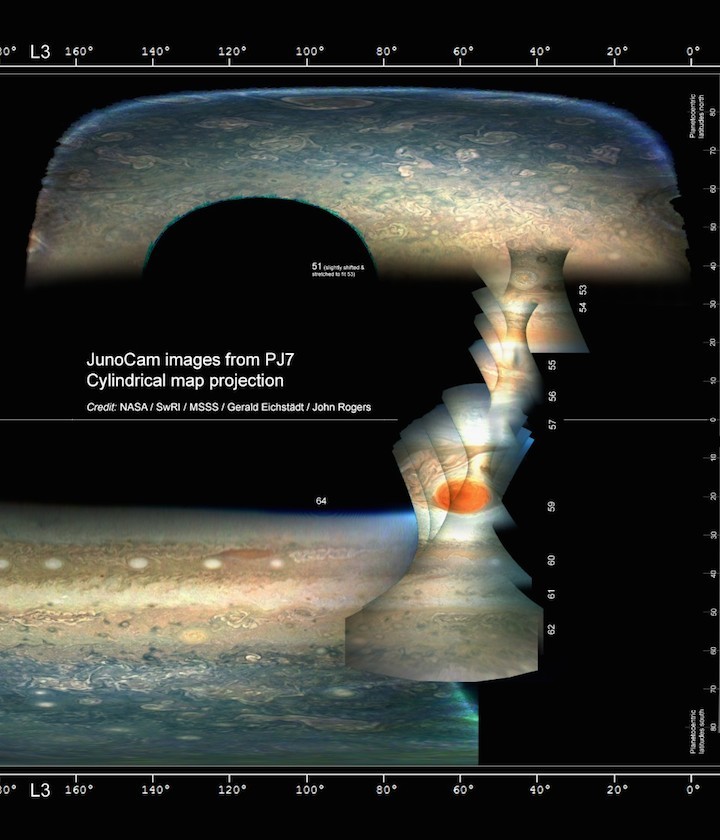

This image shows NN-LRS-1, LRS for "Little Red Spot". It is reprojected from raw Perijove-07 image #53 to 2017-07-11T01:43:50.000 on Juno's trajectory, but was taken between 2017-07-11T01:42:08.663 and 2017-07-11T01:42:23.783 from an altitude
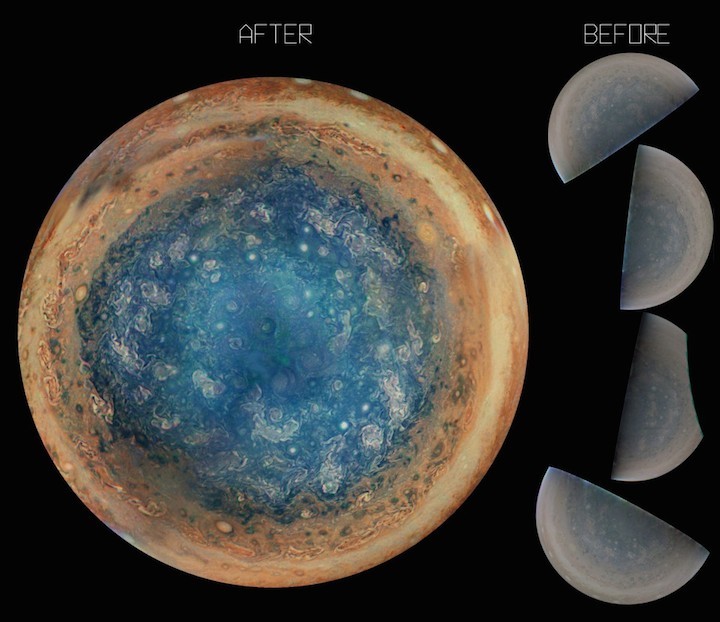
From the images of the Jupiter's south pole taken by Juno, it reminds me of Starry Night by Van Gogh.
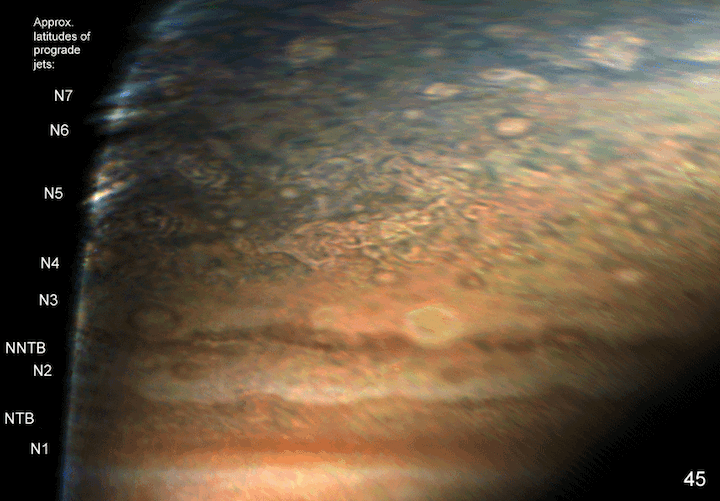
This animation compares Gerald’s maps of a northerly region shown in PJ7 images 45 and 51. Cyclonic circulation is clearly visible in the large, chaotic ‘folded filamentary region’ at the centre.
Quelle: NASA
---
Update: 30.09.2017
.
95 Minutes Over Jupiter

This sequence of color-enhanced images shows how quickly the viewing geometry changes for NASA’s Juno spacecraft as it swoops by Jupiter. The images were obtained by JunoCam.
Once every 53 days, Juno swings close to Jupiter, speeding over its clouds. In just two hours, the spacecraft travels from a perch over Jupiter’s north pole through its closest approach (perijove), then passes over the south pole on its way back out. This sequence shows 11 color-enhanced images from Perijove 8 (Sept. 1, 2017) with the south pole on the left (11th image in the sequence) and the north pole on the right (first image in the sequence).
The first image on the right shows a half-lit globe of Jupiter, with the north pole approximately at the upper center of the image close to the terminator -- the dividing line between night and day. As the spacecraft gets closer to Jupiter, the horizon moves in and the range of visible latitudes shrinks. The second and third images in this sequence show the north polar region rotating away from the spacecraft's field of view while the first of Jupiter's lighter-colored bands comes into view. The fourth through the eighth images display a blue-colored vortex in the mid-southern latitudes near Points of Interest "Collision of Colours," "Sharp Edge," "Caltech, by Halka," and "Structure01." The Points of Interest are locations in Jupiter’s atmosphere that were identified and named by members of the general public. Additionally, a darker, dynamic band can be seen just south of the vortex. In the ninth and tenth images, the south polar region rotates into view. The final image on the left displays Jupiter's south pole in the center.
From the start of this sequence of images to the end, roughly 1 hour and 35 minutes elapsed.
Quelle: NASA

